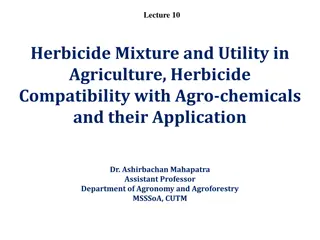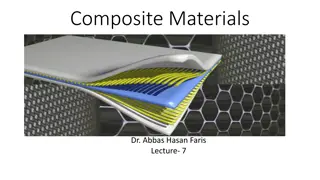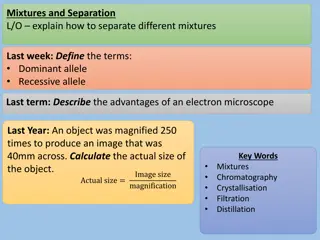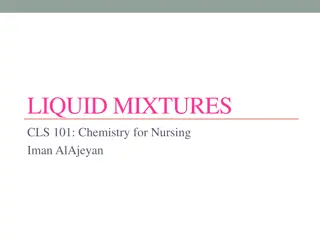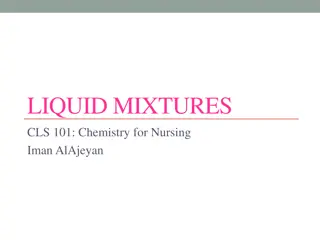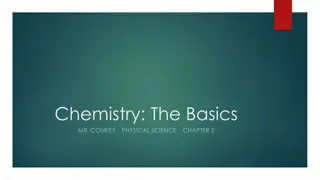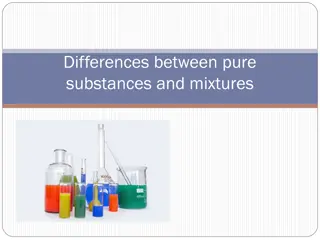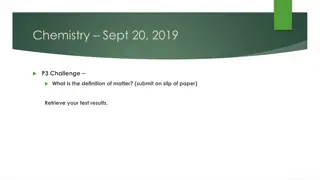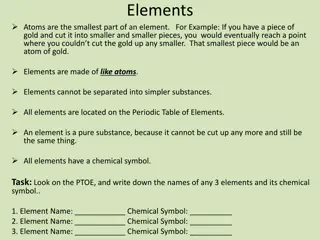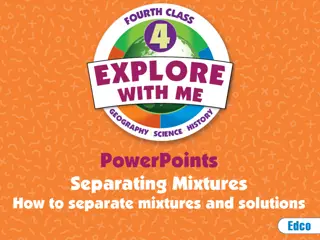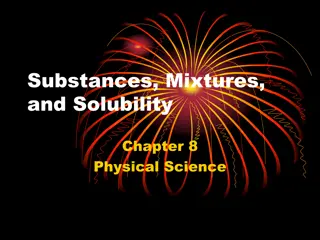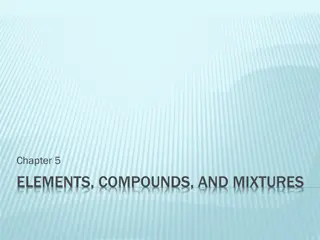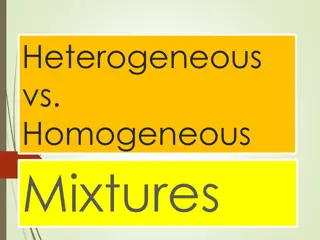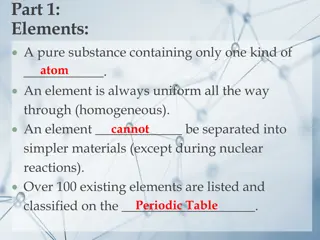Methods of Separating Mixtures in Natural Sciences Grade 7
Separating mixtures is an essential part of studying matter and materials. Methods like hand sorting, sieving, and using a magnet are commonly used to separate substances based on physical properties. Hand sorting involves sorting by size, color, texture, and shape, while sieving uses sieves with different-sized holes to separate solids of varying sizes. Using a magnet is effective for separating magnetic materials like iron. These methods are crucial in various industries, from food processing to construction, for ensuring product quality.
Download Presentation

Please find below an Image/Link to download the presentation.
The content on the website is provided AS IS for your information and personal use only. It may not be sold, licensed, or shared on other websites without obtaining consent from the author.If you encounter any issues during the download, it is possible that the publisher has removed the file from their server.
You are allowed to download the files provided on this website for personal or commercial use, subject to the condition that they are used lawfully. All files are the property of their respective owners.
The content on the website is provided AS IS for your information and personal use only. It may not be sold, licensed, or shared on other websites without obtaining consent from the author.
E N D
Presentation Transcript
Natural Sciences Grade 7 Term 2: Matter and Materials Separating mixtures (ppt 2)
Topic 2 Separating mixtures Methods of physical separation Natural Sciences - Grade 7
Hand sorting Hand sorting Sorting by hand (according to physical properties of size, colour, texture and shape). It is cheap and easy, but it can take a long time. Prior to fruit being sent to the market, it is hand sorted and packed according to quality and size. Natural Sciences - Grade 7
Hand sorting Hand sorting - - examples examples Thorns from sheep s wool (after shearing, the fleece is cleaned and the thorns are removed); Beans from rice; Beads from buttons; Nuts from bolts and screws; Paper clips from safety pins; Rice from lentils; etc. Natural Sciences - Grade 7
Sieving [1] Sieving [1] Sieving is a method used to separate: - two solids that have particles of different sizes - a liquid from a solid Sieves have holes that are all of the same size. Sieves allow small particles / liquids to pass through the holes The bigger particles [solids] are too big and it cannot pass through the sieve s holes so it remains in the sieve. Natural Sciences - Grade 7
Sieving [2] Sieving [2] In the past, tea strainers (small sieves) were used to pour the tea leaves that were mixed with boiling water through it. Presently teabags (made from a paper-like material), are used and it works as a filter. Kitchen sieves are also used to strain cooked rice / pasta and to sift cake flour. Natural Sciences - Grade 7
Sieving [3] Sieving [3] Gold diggers use a special sieve to separate gold nuggets from the sand and water. Natural Sciences - Grade 7
Sieving [4] Sieving [4] Before the builders can use the sand to make plaster, they use industrial size sieves to separate the sand from the stones and other impurities. Natural Sciences - Grade 7
Using a magnet [1] Using a magnet [1] Magnets can attract iron (Iron, nickel and cobalt are magnetic elements). The difference in the properties makes it possible to separate a magnetic substance that is mixed with a non-magnetic (aluminium and copper) substance. Plastic and glass (non-metals), are not attracted to magnets. Natural Sciences - Grade 7
Using a magnet [2] Using a magnet [2] Magnetic substances are recovered from domestic ways to be recycled by using magnets. Magnets can sort iron nails from broken glass and iron filings from sand and salt. Natural Sciences - Grade 7
Evaporation [1] Evaporation [1] Salt can be retrieved out of the sea water by evaporation. The process of separating a mixture by turning the liquid / solvent part (water)into a gas (water vapour), is called evaporation. The crystals of salt (solutes) are left behind when salt water evaporates. Natural Sciences - Grade 7
Evaporation [2] Evaporation [2] The Cerebos salt factory in Coega, near Port Elizabeth, retrieves the salt from sea water, which is held in shallow evaporating pans, by evaporation. The salt is produced for commercial use. The energy to evaporate water from the salt pans, is provided by the wind and the sun. Salt can eventually be collected after the water had become more salty from moving through a series of ponds. Natural Sciences - Grade 7
Distillation [1] Distillation [1] Distillation (evaporation followed by condensation) is used to collect the solute as well as the solvent when a solution is separated. The solution is heated. The solvent evaporates and the vapour is collected when the solution is heated. The vapour is cooled so that it condenses and becomes a liquid. Pure water can be collected from sea water through the process of distillation. Natural Sciences - Grade 7
Distillation [2] Distillation [2] When salt water is heated in a pot, the water evaporates from the solution and eventually it condenses on the pot s lid. The distillation process needs a lot of heat energy which makes it very expensive. Distillation makes it possible to separate the mixture of two liquids with different boiling points, e.g. mixture of water [100 C] and ethanol [78,37 C]. Natural Sciences - Grade 7
Distillation [3] Distillation [3] Liebig condensers Liebig condensers Natural Sciences - Grade 7
Chromatography [1] Chromatography [1] The special substances that give colour to living tissues, paint, ink and specific materials, are pigments. Pigments are responsible for the dye used in certain fabrics, as well as the red colour in blood. There is more than one pigment in the ink of pens. Chromatography is used to separate a mixture of different pigments. Certain pigments dissolve easier than others. Natural Sciences - Grade 7
Chromatography [2] Chromatography [2] Alcohol / Water can be added as a solvent to a mixture of pigments and it can travel through paper. Colours of the different pigments that were used to make ink can be identified as follows: less soluble pigments covers a short distance through the paper, because it travels slower. more soluble pigments covers a longer distance through the paper, because it travels faster. Natural Sciences - Grade 7
Chromatography [3] Chromatography [3] Natural Sciences - Grade 7


